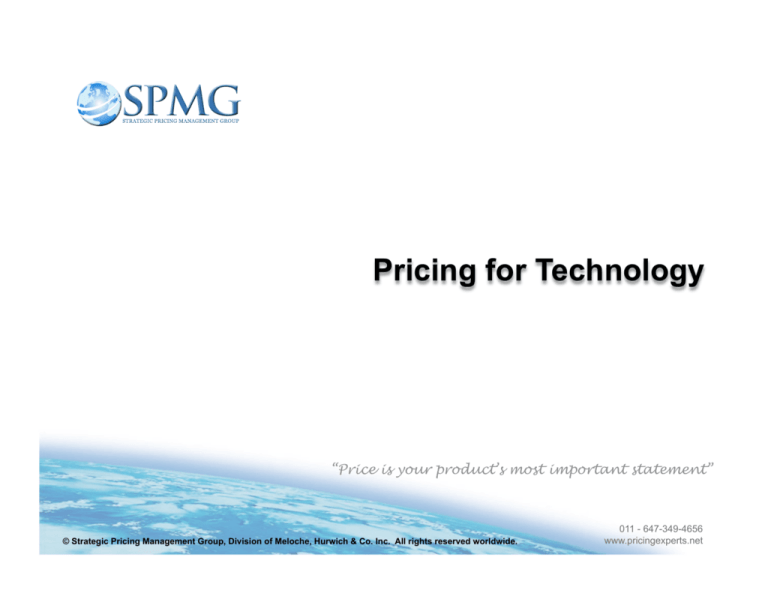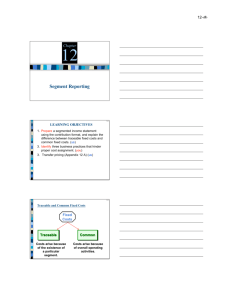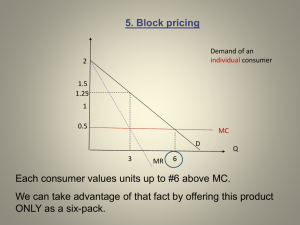
Pricing for Technology
“Price is your product’s most important statement”
© Strategic Pricing Management Group, Division of Meloche, Hurwich & Co. Inc. All rights reserved worldwide.
011 - 647-349-4656
www.pricingexperts.net
SECTION 1
The Pricing Opportunity
2
2
Improve by 1%
Operating Profit Improvement
Price
12.3
Variable Cost
8.7
Volume
Fixed Cost
3.6
2.6
Source: Compustat composite of 3,000 companies
3
3
Phillips
238
%
Sony
120
%
Panasonic
88%
Hitachi
73%
Xerox
72%
Konica Minolta
53%
Sharp
Samsung
Nokia
37%
Industry
Average
44%
13%
11%
Source: SKP analysis based on latest publicly available full year financial results
* Price increase across the board, volume consistent
4
SECTION 2
Four Methods of Pricing
5
5
1.
Cost - Based Pricing
2.
Competition - Based Pricing
3.
4.
“Gut” - Based Pricing
Value - Based Pricing
6
Cost-based pricing is perhaps the oldest form of pricing. It involves adding a
fixed mark-up to a product's cost to ensure a target margin.
Price = ( 1 + target margin ) x ( product cost )
Common in environments where it is difficult to know the competition’s
price
Relatively easy to implement and use on a day-to-day basis
Effective at ensuring the product is sold at the target margin
May not be effective at ensuring the product achieves other important
objectives ESPECIALLY WHEN TRANSFER OR OTHER ALLOCATED
FIXED COSTS ARE ADDED TO THE COST FORMULA “Sound
Familiar”
This approach is a problem when launching new products
7
Competition-based pricing sets a product’s price by adding a set premium – or
discount – to the price of a competing product (or basket of products).
Price = { 1 + ( target premium or discount ) } x ( competition’s price)
Common in environments where the competition’s price is very visible and/
or rapidly changing
•
Often called “reference” pricing
Relatively easy to implement and use on a day-to-day basis
Effective at ensuring the product is sold at the target premium or discount
May not be effective at ensuring the product achieves other important
objectives.
8
8
• Typically based on past experiences of a senior team or leader
• Draws from past customer and competitor responses
• Easy to apply
• Still common approach to pricing
9
Situation:
In mid-2000s, 3 leading gaming console producers introduced new
products, ignoring the most important element in any transaction:
Value ascribed by the buyer to a product
Result:
Prices cut prices to stimulate sales
10
• Product fails to generate expected sales volume
• Price cuts to meet volume targets, followed by competition, leading
to price wars
• Loss of time for product penetration; becoming more important as
lifecycles are becoming shorter
• Negative press coverage and loss of credibility
Results:
Increased artificial focus on price
Less attention on product’ technical advantages
11
Price of a product tied to attributes customers use when determining the
benefits of a product/ service.
Example of benefits: use of a product or service may provide dollar savings
Incremental Price = some fraction of ( savings vs. best alternative )
Common for new product pricing – especially in the case of very
innovative products
Not an approach that can be implemented rapidly; requires careful
consideration of alternatives and their pros and cons
Not always effective at ensuring the product achieves its objectives
12
SECTION 3
Value-Based Pricing
13
Value ascribed to an offering will not likely be the same for all segments or
customers within a segment.
Value to
Customers
International
Software applied to:
External Customers
Internal Users
National
Software applied to:
External Customers
Internal Users
Regional
Software applied to:
External Customers
Internal Users
Enhanced
customer
relationships
Lower
transaction
costs
Reduce
operating
costs
Broaden
exposure to
market
Efficient
transfer of
information
Maximize
breadth of
products/
services
available
14
- B2C : Conjoint Analysis
- B2B : Value Chains
15
• A key element is the presentation of complete offers containing all the
important attributes of a product
• Data analysis includes: importance of each factor (attribute) and utility
calculation for each offer, based on the respondents’ evaluation and
choices
• The offers presented in the survey represent some possible
combinations –the conjoint allows inference from a smalL number of direct
measurements
16
16
Which vehicle would you be most likely to purchase from among these choices?
Chevy Malibu
Dodge Stratus
Nissan Altima
V6 engine
AM/FM radio w/CD
$18,500
V6 engine
AM/FM radio
V4 engine
AM/FM radio w/
cassette
$19,500
$17,500
1
2
3
17
I wouldn’t
purchase any of
these if they
were my only
choices
4
17
Surveys based on Conjoint Analysis give answers to several important
questions.
– Will the new product meet customers’ approval?
– What factors do influence purchase decisions?
– How different are different market segments?
– What changes in the offer will have highest impact?
– What price is acceptable? What price maximizes sales value?
18
18
The value chain for customers of a software applications developer providing a
strategic planning tool could be summarized as below. The incremental value
provided by the tool contained two value components:
Incremental revenue
Cost savings
Establish
Objectives
Translate into
Strategy
Convert into
Plans
Monitor
Adjust
Strategic Planning Tool
19
Establish
Objectives
Translate
into
Strategy
Key Activities
Convert
into
Plans
Monitor
Adjust
Estimated $ Value
Incremental Value Added
• Collect data on
performance
• Review performance
relative to metrics defined in
Planning
• Reduces work needed to combine
data on performance with metrics
• Reduces time required to
demonstrate and build buy-in to
cause and effect analyses
• Minimizes response time thereby
minimizing lost revenues
• Trend analysis
Revenue
Large Small
Person-days: All-in cost/day Incremental
Benefit:
Person-days:
All-in cost/day Incremental
Benefit:
-
Cost
Large Small
10
5
$375
$375
$3.75 K
-
10
$375
-
$3.75 K
-
$3.75K
7
$375
$2.63K
Person-days:
All-in cost/day
Incremental
benefit:
-
-
-
-
$5K
$2K
-
-
TOTAL:
$5K
$2K
$7.5K
• Analyze cause and effect
$6.38K
$12.5 K
20
Calculate a segment-specific premium (and weight it):
•
reflective of the value of the product to the segment
•
based on factors identified through internal knowledge and external customer
interviews.
Section 4
Putting it Together:
The Price/ Value Map
22
This matrix will help you organize your strategies &
tactics to make a well-informed pricing decision
Medium
Low
Value
High
High
Price
Medium
Low
1. Premium
2. Penetration
3. Superb Value
4. Overcharging
5. Fair Value
6. Good Value
7. Rip-Off
8. Cream-Skimming
9. Cheap Value
23
VALUE/PRICE Relationship
Your
Company
10
}
7
Value
Rating
Competitor
s
5
0
0
5
7
Price Rating
Scale 0-9 = Ranking Importance of Decision Criteria
24
10
Illustration Only
SPMG: OVERVIEW
25
Years of consultative pricing experience through innovation, research and hands-on management
have positioned the consultants at Strategic Pricing Management Group (SPMG) at the cutting edge
of value-based pricing & revenue strategies and management.
The firm’s main services are strategic pricing and marketing strategy, research, corporate planning
and education. Each assignment is carefully managed using proven customized methodologies and
techniques to meet specific client needs. We have presence in North America, Europe and Asia.
Projects in the last year
SPMG Offices.
Partner Offices.
26
Research
Client/Consumer Value Drivers research
Price change impact research
Transactional analysis/ Modélling
Client Value & Satisfaction studies
Product potential & ‘Willingness to pay’
Client/Consumer segmentations
…..
Advisory
•
•
•
•
•
•
•
Value Based Pricing
Pricing Strategies & Tactics
Competitive Pricing / Price Wars
Implementing Price Increases
Channel Pricing
New Product Launch
….
•
•
•
•
•
•
•
•
Sales Force Training / Motivation
Support/ Training of Pricing / Marketing teams
Decision Support Systems
Deployment & management of ‘Test Platforms’
Product/Service Full Cost Analysis
Pricing Process deployment
Pricing & Competitive Intelligence & Benchmarking
…..
•
•
•
•
•
•
•
•
Development / Reinforcement of Pricing Capabilities
Redéployment of Pricing Processes
Management & optimization of ‘client conditions ’
Multi-Channel Pricing / Pricing Corridors
Change Management
Value Propositions / Design to Price
Pricing Software implementation
27
…..
Support
•
•
•
•
•
•
•
Process
Pricing
Management
Pricing
Strategy
Range of services
28
North America
Canada – H.Q
Michael Hurwich, CEO & President
Zoltan Lorantffy, Director
Info@youneedpricing.com
United States
Alain Meloche , Managing Partner
ameloche@youneedpricing.com
Europe
Europe
Loic Le Corre, Managing Partner
llecorre@youneedpricing.com
Western Europe - France
Eric Jacolin, Partner
ejacolin@youneedpricing.com
Western Europe - Germany
Heinz Otto Luehr , Partner
holuehr@youneedpricing.com
Central and Eastern Europe - Hungary
Eniko Pongracz, Partner
epongracz@youneedpricing.com
Asia
China -Hong Kong
Edward Chan P, Eng, Partner
echan@youneedpricing.com
Indonesia - Tangerang
Erwin Husin, Partner
ehusin@youneedpricing.com
Latin-America
Brazil - Rio de Janeiro
Alex Carneiro, Partner
acarneiro@youneedpricing.com
Mexico – Mexico City
Miguel Legorreta, MBA , Partner
mlegorreta@youneedpricing.com
29







